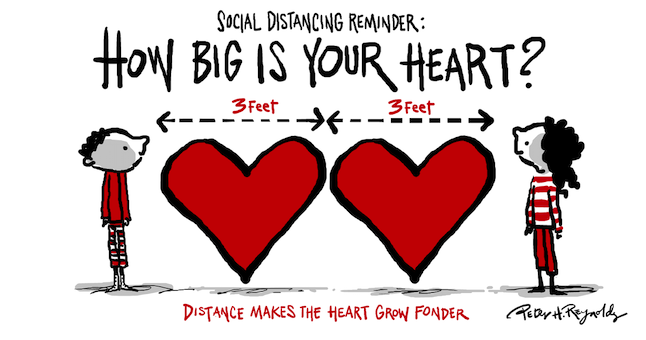Kindness and Gratitude in Our Time of Crisis

“I’ve been searching for ways to heal myself, and I’ve found that kindness is the best way.” – Lady Gaga
Today many teachers are scrambling to figure out how to adapt their teaching methods to online instruction at the same time they are home with their own children attempting to help them navigate new ways of learning.
The world has suddenly gone a little sideways, and the abrupt necessity to create new routines and procedures is formidable.
We get mixed messages from “the experts” about what to expect from COVID-19, and many of us can’t find enough eggs or toilet paper for our families. In the midst of chaos, our bodies tend to produce more cortisol, which can send us into anxiety or depression. Our brains may be sending us messages such as, “I’m overwhelmed – I can’t do this,” or “This is horrible, and it will never be right again.”
Understandably teachers, like everyone else, are concerned, anxious, and unnerved. The COVID-19 crisis has brought us to unstable and scary circumstances. In order for teachers to help students not only survive but also thrive through these contemporary challenges, we need to underscore both theirs and our fundamental need for kindness and gratitude.
Dr. Abdu Sharkawy, an infectious disease specialist, laments the panic-induced, self-absorbed behavior of some adults who finger-point, hoard, and break the rules.
“. . . I’m scared about what message we are telling our kids when faced with a threat. Instead of reason, rationality, open-mindedness and altruism, we are telling them to panic, be fearful, suspicious, reactionary and self-interested.” Source
For both our own sakes as well as our children’s we need to be sure we stop, take a breath, and focus on what we can do for others and on how we can shift our attention to things for which we are grateful.
Responding to students’ concerns
After schools unexpectedly began shutting down, many students were confused, saddened, and afraid. In one of my neighboring communities a group of teachers formed a parade in their individual cars and drove through the neighborhoods of their students honking their horns and waving. Kids and their parents stood in the yards and looked out windows, responding with smiles and vigorous returning waves.
In our community a parent posted a FaceBook picture of her son gleefully displaying the card and stickers he had just received in the mail from his teacher. A teacher I read about bought 200 brightly-colored envelopes and pieces of stationery to send a comforting letter to her students with a personalized note at the bottom for each one.
Teachers across the country are performing countless acts of kindness to help students feel connected and valued. They are calling, texting, emailing, FaceTiming and using other approved social-distancing methods for staying in contact with kids. They are going beyond online curriculum instruction to help bolster social-emotional learning skills in their viewers.
The psychological power of kindness
Putting our energies into things we can control infuses us with self-efficacy, and some studies have shown that acting on behalf of others can rewire our brains towards more positive emotions. Neuropsychologists are fond of saying “Neurons that fire together, wire together.”
One of the most positive aspects about purposefully being kind to someone as well as intentionally concentrating on gratitude is that both cause a shift away from negative emotions towards positive ones. It is physically impossible to hold negative thoughts in our brains at a time we are experiencing true gratitude or authentic altruism.
For our own benefit as well as those of our students, we need to make the time to cultivate thoughtfulness and gratitude. Anxiety and depression are not inevitable if we take affirmative steps to combat them. Rather than fixating on “scarcity theory,” we need to think about what we can share with others. Instead of mourning what we’ve lost, we can celebrate what we have. The positive outcomes of practicing kindness and gratitude on a daily basis include:
- Lessen feelings of social isolation
- Increase joy and optimism
- Enhance acting with more generosity and compassion
- Improve physical health (Wilson & Conyers, 2015).
Until our world “rights itself,” the best thing we can do is remain calm, breathe (practicing mindfulness is preferred), and focus on those things we can control – like the way we view our current circumstances.
Here are some suggestions for teachers to practice themselves as well as to encourage students to perform:
Demonstrate Kindness
♦ Let someone else have the last of the toilet paper, the biggest slice of pizza, or the most time on the computer. Smile and tell them you’re doing it because you think they’re worth it.
♦ Teach someone a new skill or tell them about something interesting.*
♦ Send someone a homemade picture, card, poem, video or something else you created just for them.
♦ Volunteer to help with a chore or a work duty that is hard for someone else.*

Time and other publications are featuring neighborhood bear hunts. This critter was spotted in Athens, GA.
♦ Put friendly and/or funny pictures and signs on your outside doors and windows to bring a smile to neighbors who are walking around.
♦ If you are healthy and well, ask an elderly or health-compromised neighbor if they’d like for you to go to the pharmacy, pick up some groceries, or do another task for them.*
♦ Call your grandparents (or other elderly family and friends) just to say “hello.” Patiently listen to their stories and their advice.
♦ Volunteer to watch a younger sibling while your parent takes a break.
♦ Make a YouTube of you reading a story to younger children; then let parents know it is available.
♦ On social media stand up to bullies who belittle your classmates. Let the victims know you support them.
[* Do these things with precautions about social distancing.]
Cultivate Gratitude
♦ Stop right now (seriously, quit reading and do this – you’ll be glad you did) and write down at least 10 things you are grateful that you still have in spite of the COVID-19 crisis.
♦ Write a letter to someone who has made an impact on your life. Tell them exactly what they did that made a difference for you. You can mail it or call them and read it to them (preferred).
♦ Before you go to bed each night, either mentally or in a journal (preferred) write down the things you are grateful for. They can be small (“We had ice cream for dessert,” “I get to sleep late these days,”) or large (“We have all the water we need,” “I am safe,” “I have people who care about me.”)
♦ Keep a pad of sticky notes and a marker in a handy place. Ask everyone in the house to regularly jot down things for which they are thankful and stick them somewhere specific like the refrigerator door or a wall in the living area. (Remind people to be genuine; comments should be positive.)
♦ Make lists of everyone who is housebound with you during this Shelter in Place time. Leave space for comments under each name. Ask each household member to take a list and write down at least three things they appreciate about every other household member. At a meal or other gathering take turns sharing your comments. (Again, authenticity and positivity are the aims.)
♦ Visit our website Teaching Kids to Thrive and under Chapter Resources click on Chapter 10. There you will find activities and resources with lot of ideas for teaching and learning about gratitude. Try some.
♦ Write me, Dr. Debbie Silver, at debbie@debbiesilver.com, and tell me your ideas and experiences with practicing kindness and gratitude.
Reference
Wilson, D., & Conyers, M.(2015, Sept.30). Unleashing the power of positivity in your school. Edutopia.
_______________________________________________________




































Teaching Kids to Thrive: Essential Skills for Success is co-written with Dedra Stafford. We shared the writing duties for that book.
I agree with alot of things she’s saying and I am going to try some of her techniques at home
Good to hear from you Kesha! Let me know how your implementation goes. All best wishes to you and your students.